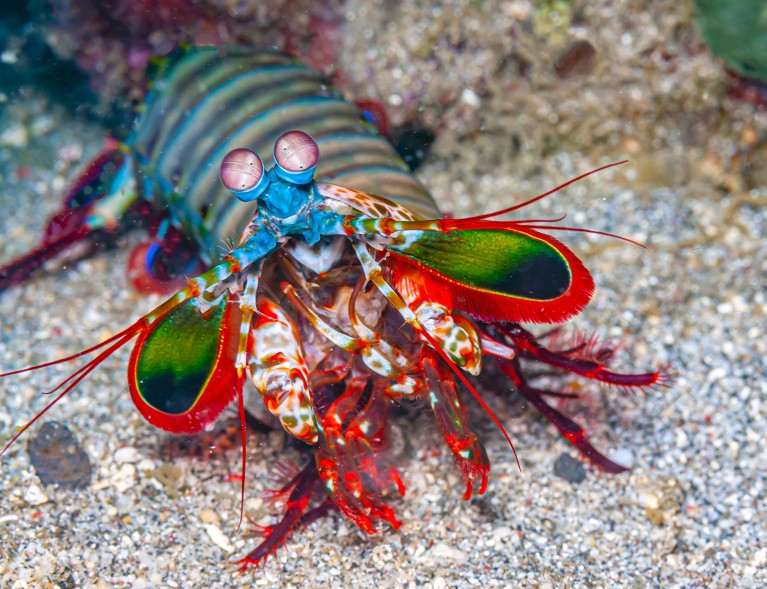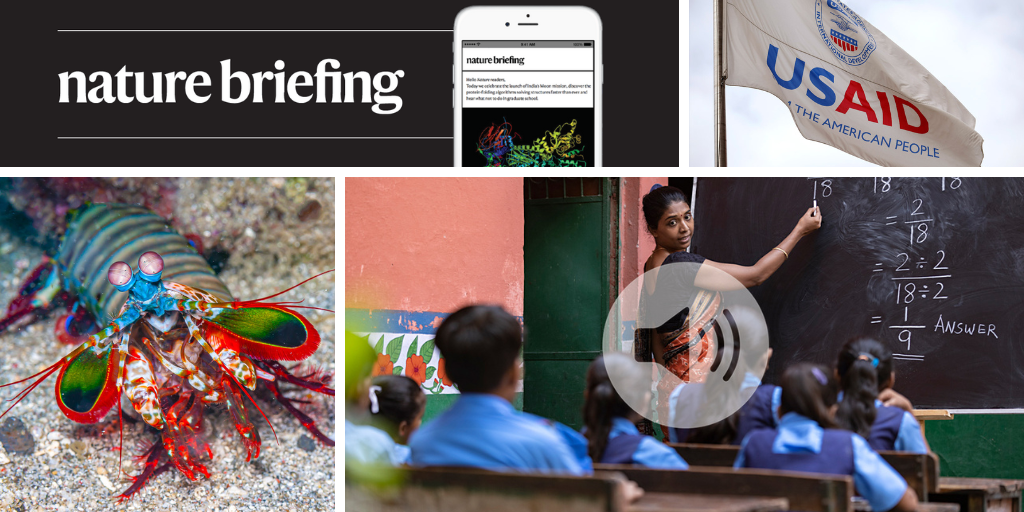Hello Nature readers, would you like to get this Briefing in your inbox free every day? Sign up here.

The mantis shrimp can smash through the shells of prey with its powerful strike. Credit: johnandersonphoto/Getty
Peacock mantis shrimp (Odontodactylus scyllarus) might be small, but thanks to a specialized limb, they pack a mighty punch. Their jabs are strong enough to crack the shells of other crustaceans, and now researchers have worked out how they can do it without damaging their own body. The punching limb, called the dactyl club, has a multi-layered structure that allows it to absorb the shockwaves generated on impact. The findings could provide inspiration for the design of artificial materials with useful properties, says physicist and study co-author Maroun Abi Ghanem.
Bacteria that colonize the nose have been engineered to ferry drugs to the brains of mice. Researchers examined bacteria in the nasal microbiome and identified the species Lactobacillus plantarum as both safe to use in treatment and able to bind to a molecule found on a nose membrane connected to the brain. They then engineered L. plantarum to produce and secrete three appetite-suppressing hormones. Obese mice that received a dose of the bacteria in their nose each day for eight weeks ate less and lost weight during the treatment period. The bacteria probably don’t enter the brain themselves, but carry the drug to the point where it can diffuse the rest of the way.
Tech giant OpenAI has unveiled a pay-for-access tool called ‘deep research’, which synthesizes information from dozens or hundreds of websites into a cited report. The tool’s ability to write literature reviews and identify gaps in knowledge has impressed many scientists, but others have noted that its output is not up to the standard you’d expect from a human. Its launch follows that of a similar tool from Google, also called Deep Research, released in December. Artificial-intelligence systems like these could be used to update human-authored reviews more regularly than is feasible for humans, say experts, although OpenAI admits the tool is currently prone to hallucinations and false citations.
Features & opinion
Members of advantaged groups can lighten the load of efforts to create a diverse, equitable and inclusive academia — a load that is often disproportionately shouldered by members of disadvantaged groups. It’s worth it: a simulation tool suggests that having even a small proportion of people in a network engaging in allyship actions can foster greater inclusion for those at risk of being marginalized. Behavioural scientist Hsuan-Che ‘Brad’ Huang, and social psychologists Lucy De Souza and Toni Schmader, offer six actionable steps for academics who want to step up to the plate for their colleagues.
Nature Human Behaviour | 9 min read
A cryogenically frozen man wakes up in a future that’s less welcoming than he’d hoped in the latest short story for Nature’s Futures series.
Andrew Robinson’s pick of the top five science books to read this week includes a roundup of innovations that changed the course of history and reflections from a poet and a space historian on humanity’s fascination with Mars.
Mathematics skills learnt in real-world situations might not translate to the classroom and vice versa. A team surveyed children in India who work in markets and found that, although the kids could quickly solve complex market-based problems in their heads, they struggled with calculations typically used in schools. The reverse was seen for schoolchildren who had no market-selling experience. The researchers hope this finding could help design curricula that bridge the gap between intuitive and formal maths. “What matters is that kids can systematically solve problems, not that they use the right algorithm,” says economist and study co-author Abhijit Banerjee.
Nature Podcast | 35 min listen
Subscribe to the Nature Podcast on Apple Podcasts, Spotify or YouTube Music, or use the RSS feed.
This week, Leif Penguinson has swum up to the shores of Tjøme island in Norway. Can you find the penguin?
The answer will be in Monday’s e-mail, all thanks to Briefing photo editor and penguin wrangler Tom Houghton.
This newsletter is always evolving — tell us what you think! Please send your feedback to [email protected].
Flora Graham, senior editor, Nature Briefing
With contributions by Jacob Smith
Want more? Sign up to our other free Nature Briefing newsletters:
• Nature Briefing: Careers — insights, advice and award-winning journalism to help you optimize your working life
• Nature Briefing: Microbiology — the most abundant living entities on our planet — microorganisms — and the role they play in health, the environment and food systems
• Nature Briefing: Anthropocene — climate change, biodiversity, sustainability and geoengineering
• Nature Briefing: AI & Robotics — 100% written by humans, of course
• Nature Briefing: Cancer — a weekly newsletter written with cancer researchers in mind
• Nature Briefing: Translational Research — covers biotechnology, drug discovery and pharma



